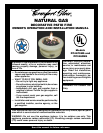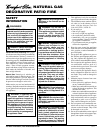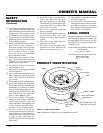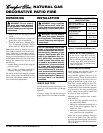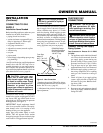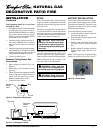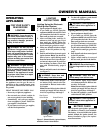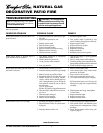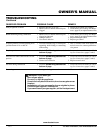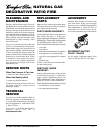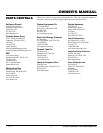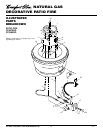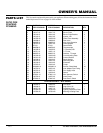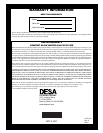Special offers from our partners!

Find Replacement BBQ Parts for 20,308 Models. Repair your BBQ today.

For more information, visit www.desatech.com
5
107214
OWNER’S MANUAL
CONNECTING TO GAS
SUPPLY
Installation Items Needed
Before installing appliance, make sure your
installer has the items listed below.
• piping (check local codes)
• sealant (resistant to propane/LP gas)
(May be pipe dope or Teflon tape)
• equipment shutoff valve *
• test gauge connection *
• adjustable (crescent) wrench or pliers
• sediment trap
• tee joint
• pipe wrench
• brass fitting(s) (depending upon gas sup-
ply plumbing)
* An CSA/AGA design-certified equipment
shutoff valve with 1/8" NPT tap is an ac-
ceptable alternative to test gauge connec-
tion. Purchase the optional CSA/AGA de-
sign-certified equipment shutoff valve from
your dealer. See Accessory, page 10.
CAUTION: Use only new,
black iron or steel pipe. Inter-
nally-tinned copper tubing may
be used in certain areas. Check
your local codes. Use pipe of 1/2"
diameter or greater to allow
proper gas volume to appliance.
If pipe is too small, undue loss of
pressure will occur.
We recommend that you install a sediment
trap in supply line as shown in Figure 3.
Locate sediment trap where it is within
reach for cleaning. Install in piping system
between fuel supply and patio firepit. Lo-
cate sediment trap where trapped matter is
not likely to freeze. A sediment trap traps
moisture and contaminants. This keeps them
from going into appliance controls. If sedi-
ment trap is not installed or is installed
wrong, appliance may not run properly.
Installation must include an equipment
shutoff valve, union, and plugged 1/8" NPT
tap. Locate NPT tap within reach for test
gauge hook up. NPT tap must be upstream
from appliance (see Figure 3).
IMPORTANT:
Install equipment shutoff
valve in an accessible location. The equip-
ment shutoff valve is for turning on and
shutting off the gas to the appliance.
Apply pipe joint sealant lightly to male
threads. This will prevent excess sealant
from going into pipe. Excess sealant in pipe
could result in a clogged burner injector.
CAUTION: Use pipe joint seal-
ant that is resistant to liquid pe-
troleum (LP) gas.
Figure 3 - Gas Connection
* Purchase the optional CSA/AGA design-
certified equipment shutoff valve from your
dealer. See Accessory, page 10.
** Minimum inlet pressure for purpose of
input adjustment.
INSTALLATION
(Continued)
Continued
3" Minimum
Sediment Trap
From Gas
Meter (5"
W.C.** to 10.5"
W.C. Pressure)
CSA/AGA Design-
Certified Equipment
Shutoff Valve With
1/8" NPT Tap*
Tee Joint
Pipe Nipple Cap
To
Patio Firepit
WARNING: Never use an open
flame to check for a leak. Apply a
mixture of liquid soap and water
to all joints. Bubbles forming show
a leak. Correct all leaks at once.
WARNING: Test all gas pip-
ing and connections for leaks
after installing or servicing. Cor-
rect all leaks at once.
CHECKING GAS
CONNECTIONS
Pressure Testing Gas Supply
Piping System
Test Pressures In Excess Of 1/2 PSIG
(3.5 kPa)
1. The appliance and its individual shutoff
valve must be disconnected from the
gas supply piping system during any
pressure testing of that system at test
pressures in excess of 1/2 psi (3.5 kPa).
2. Cap off open end of gas pipe where
equipment shutoff valve was connected.
3. Pressurize supply piping system by ei-
ther using compressed air or opening
main gas valve located on or near gas
meter.
4. Check all joints of gas supply piping
system. Apply mixture of liquid soap
and water to gas joints. Bubbles form-
ing show a leak.
5. Correct all leaks at once.
6. Reconnect unit and equipment shutoff
valve to gas supply. Check reconnected
fittings for leaks.



